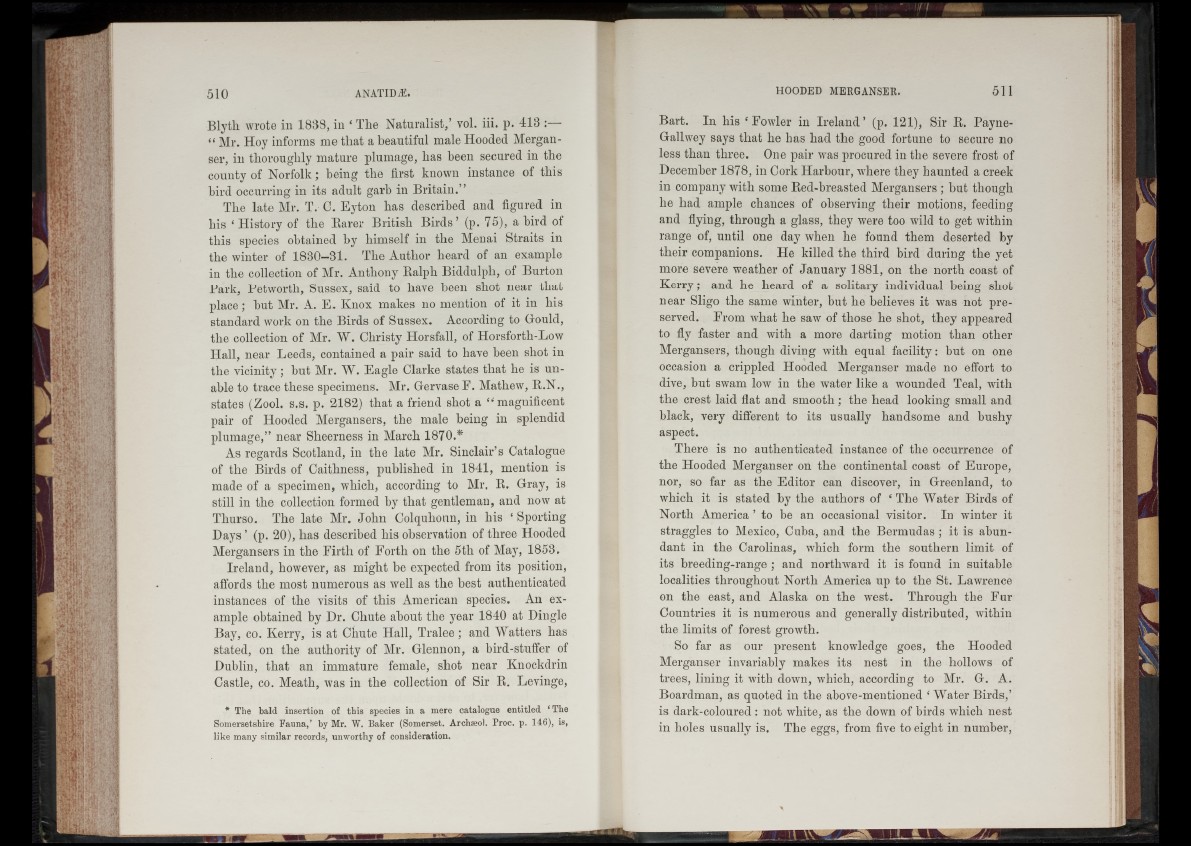
Blytli wrote in 1888, in * The Naturalist,’ vol. iii. p. 418 :
“ Mr. Hoy informs me that a beautiful male Hooded Merganser,
in thoroughly mature plumage, has been secured in the
county of Norfolk ; being the first known instance of this
bird occurring in its adult garb in Britain.”
The late Mr. T. C. Eyton has described and figured in
his £ History of the Barer British Birds’ (p. 75), a bird of
this species obtained by himself in the Menai Straits in
the winter of 1830—31. The Author heard of an example
in the collection of Mr. Anthony Balph Biddulpli, of Burton
Park, Petworth, Sussex, said to have been shot near that
place; but Mr. A. E. Knox makes no mention of it in his
standard work on the Birds of Sussex. According to Gould,
the collection of Mr. W. Christy Horsfall, of Horsforth-Low
Hall, near Leeds, contained a pair said to have been shot in
the vicinity ; hut Mr. W. Eagle Clarke states that he is unable
to trace these specimens. Mr. GervaseF. Mathew, B.N.,
states (Zool. s.s. p. 2182) that a friend shot a “ magnificent
pair of Hooded Mergansers, the male being in splendid
plumage,” near Sheerness in March 1870.*
As regards Scotland, in the late Mr. Sinclair’s Catalogue
of the Birds of Caithness, published in 1841, mention is
made of a specimen, which, according to Mr. K. Gray, is
still in the collection formed by that gentleman, and now at
Thurso. The late Mr. John Colquhoun, in his ‘ Sporting
Days ’ (p. 20), has described his observation of three Hooded
Mergansers in the Firth of Forth on the 5tli of May, 1853.
Ireland, however, as might be expected from its position,
affords the most numerous as well as the best authenticated
instances of the visits of this American species. An example
obtained by Dr. Chute about the year 1840 at Dingle
Bay, co. Kerry, is at Chute Hall, Tralee ; and Watters has
stated, on the authority of Mr. Glennon, a bird-stuffer of
Dublin, that an immature female, shot near Knockdrin
Castle, co. Meath, was in the collection of Sir R. Levinge,
* The bald insertion of this species in a mere catalogue entitled ‘ The
Somersetshire Fauna,’ by Mr. W. Baker (Somerset. Archeeoi. Proc. p. 146), is,
like many similar records, unworthy of consideration.
Bart. In his ‘Fowler in Ireland’ (p. 121), Sir R. Payne-
Gallwey says that he has had the good fortune to secure no
less than three. One pair was procured in the severe frost of
December 1878, in Cork Harbour, where they haunted a creek
in company with some Red-breasted Mergansers ; but though
he had ample chances of observing their motions, feeding
and flying, through a glass, they were too wild to get within
range of, until one day when he found them deserted by
their companions. He killed the third bird daring the yet
more severe weather of January 1881, on the north coast of
Kerry; and he heard of a solitary individual being shot
near Sligo the same winter, but he believes it was not preserved.
From what he saw of those he shot, they appeared
to fly faster and with a more darting motion than other
Mergansers, though diving with equal facility: but on one
occasion a crippled Hooded Merganser made no effort to
dive, but swam low in the water like a wounded Teal, with
the crest laid flat and smooth ; the head looking small and
black, very different to its usually handsome and bushy
aspect.
There is no authenticated instance of the occurrence of
the Hooded Merganser on the continental coast of Europe,
nor, so far as the Editor can discover, in Greenland, to
which it is stated by the authors of ‘ The Water Birds of
North America ’ to be an occasional visitor. In winter it
straggles to Mexico, Cuba, and the Bermudas ; it is abundant
in the Carolinas, which form the southern limit of
its breeding-range ; and northward it is found in suitable
localities throughout North America up to the St. Lawrence
on the east, and Alaska on the west. Through the Fur
Countries it is numerous and generally distributed, within
the limits of forest growth.
So far as our present knowledge goes, the Hooded
Merganser invariably makes its nest in the hollows of
trees, lining it with down, which, according to Mr. G. A.
Boardman, as quoted in the above-mentioned ‘ Water Birds,’
is dark-coloured : not white, as the down of birds which nest
in holes usually is. The eggs, from five to eight in number,